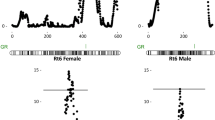Abstract
The populations of three anuran amphibian species (Amphibia, Anura) of the genus Rana (R. ridibunda Pall., R. arvalis Nilss. and R. temporaria L.) inhabiting the Yekaterinburg urban agglomeration were examined. The frequencies of two traits, morph striata and iris depigmentation, were estimated in these populations. The former trait, so-called morph striata, is phenotypically expressed as a light dorsomedial stripe. It is controlled by a dominant allele of autosomal diallelic gene striata in some species of Rana genus, exhibiting complete dominance. Striata individuals have a number of physiological features that confer them an advantage under conditions of natural and artificial geochemical anomalies. The second trait, iris depigmentation, is the result of a recessive mutation. The individuals homozygous for this trait have low viability. Thus, the dominant mutations promote rapid adaptation of their carriers. Conversely, the recessive mutations may reduce viability of an individual.
Similar content being viewed by others
References
Chetverikov, S.S., Some Stages of the Evolutionary Process from the Point of View of Modern Genetics, Zh. Eksper. Biol., Ser. A., 1926, pp. 3–54.
Vershinin, V.L., Preliminary Evaluation of Anthropogenic Influence on Amphibians in Sverdlovsk, in Problemy ekologii, ratsional'nogo ispol'zovaniya i okhrany prirodnykh resursov na Urale (Ecology, Rational Management, and Conservation of Natural Resources in the Urals), Sverdlovsk, 1980, pp. 117–118.
Vershinin, V.L., Species Composition and Biological Features of the Amphibians from Some Industrial Cities of the Urals, Extended Abstract of Cand. Sci. (Biol.) Dissertation, Sverdlovsk, 1983.
Shchupak, E.L., Inheritance of Vertebral Stripe in Common Frog, in Informatisionnye materialy Instituta ekologii rastenii i zhivotnykh (Information Material of the Institute of Animal and Plant Ecology), Sverdlovsk, 1977, p. 36.
Berger, L. and Smielowski, J., Inheritance of Vertebral Stripe in Rana ridibunda Pall. (Amphibia, Ranidae), Amphibia-Reptilia, 1982, vol. 3, pp. 145–151.
Cain, B.W. and Utesch, S.R., An Unusual Color Pattern of the Green Tree Frog, Hyla cinerea, Southwest. Nat., 1976, vol. 21, pp. 235–236.
Dubois, A., Fisher, J.-L., and Payen, D., Un Triton palme (Triturus helveticus) aux yeux noirs, C.r. Soc. Biol., 1973, vol. 167, pp. 1733–1735.
Engelmann, W.-E. and Obst, F.J., Partielle Pigmentlosigkeit bei Bufo viridis viridis (Amphibia, Anura, Bufonidae), Zool. Abh. Mus. Tierk., Dresden, 1976, vol. 34, pp. 39–41.
Rostand, J. and Darre, P., Une mutation de Rana esculenta: La grenouille aux yeux noirs, C. R. Acad. Sci. (D), 1970, vol. 217, pp. 1414–1415.
Rostand, J., Sur l'anomalie “iris brun” chez Rana esculenta L., C. r. Acad. Sci., 1953, vol. 237, pp. 762–764.
Vershinin, V.L., Prevalence of Iris Depigmentation in Urban Populations of Common Frog, Ekologiya, 2004, no. 1, pp. 69–73.
Dubois, A., Sur deux anomalies de la Genouille verte (Rana esculenta), Bull. Soc. Linn., Lyon, 1968, vol. 37, pp. 316–320.
Vershinin, V.L. and Tereshin, S.Yu., Physiological Indices of Amphibians in the Ecosystems of Urbanized Territories, Ekologiya, 1999, no. 4, pp. 283–287.
Vavilov, N.I., Zakon gomologichnykh ryadov v nasledstvennoi izmenchivosti: Linneevskii vid kak sistema (The Law of Homologous Series in Hereditary Variation: Linnean Species as a System), Leningrad: Nauka, 1967, pp. 1–92.
Chernysheva, E.V. and Starostin, V.I., Morphological Studies of Peripheral Blood Cells, in Ekologicheskoe Sostoyanie basseina reki Chapaevka v usloviyakh antropogennogo vozdeistviya: Biologicheskaya indikatsiya (Ecological Condition of the Chapaevka River Basin Under Anthropogenic Influence: Biological Indication), Tolyatti, 1997, pp. 296–298.
Vershinin, V.L., Haemopoiesis of Anuran Amphibians-Specific Adaptiogenesis of the Species in Modern Ecosystems, Zool. Zh., 2004, vol. 83, no. 11, pp. 1367–1374.
Ishchenko, V.G., Dinamicheskii polimorfizm burykh lyagushek fauny SSSR (Dynamic Polymorphism of the Brown Frogs of the Fauna of the Soviet Union), Moscow: Nauka, 1978.
Boutilier, R.G., Donohoe, P.H., Tattersall, G.J., and West, T.G., Hypometabolic Homeostasis in Overwintering Aquatic Amphibians, J. Exp. Biol., 1997, vol. 200, no. 2, pp. 387–400.
Garanin, V.I., The Data on the Distribution and Population Number of the Amphibians from the Volga-Kama Region, in Prirodnye resursy Volzhsko-Kamskogo kraya: Zhivotnyi mir (Natural Resources of the Volga-Kama Region: Animal Kingdom), Moscow: Nauka, 1964, pp. 127–133.
Astradamov, V.I., The Role of Anthropogenic Factors in the Change of Natural Complexes and Their Components (on the Example of the Mordovian Autonomous Republic), Extended Abstract of Cand. Sci. (Biol.) Dissertation, Kazan, 1973.
Toporkova, L.Ya., Amphibians and Reptilians of the Ural, in Fauna Evropeiskogo Severa, Urala i Zapadnoi Sibiri (Fauna of the European North, Ural, and Western Siberia), Sverdlovsk, 1973, pp. 84–117.
Halliday, T.R., Where Have All the Frogs Gone?, People and Planet, 1998, vol. 7, no. 4, pp. 22–23.
Makeeva, V.M., Malyuchenko, O.P., Belokon', M.M., et al., The State of the Brown Frog Natural Population Gene Pool in Anthropogenic Landscape Conditions of Moscow and Moscow Oblast, Genetika v XXI veke: sovremennoe sostoyanie i perspektivy razvitiya (Genetics in 21st Century: State of Art and Perspectives), Moscow, 2004, vol. 2, p. 211.
Altukhov, Yu.P., Geneticheskie protsessy v populyatsiyakh (Genetic Processes in the Populations), Moscow: Akademkniga, 2003.
Altukhov, Yu.P., Salmenkova, E.A., Kurbatova, O.L., et al., Dinamika populyatsionnykh genofondov pri antropogennykh vozdeistviyakh (Population Gene Pool Dynamics under Anthropogenic Influence), Altukhov, Yu.P., Ed., Moscow: Nauka, 2004.
Simberloff, D., What a Species Needs To Survive, Nat. Conserv. News, 1983, vol. 33, no. 6, pp. 18–22.
Surova, G.S., Onthogenic Mechanisms Providing Stability of the Brown Frog Larvae Populations, Problemy evolyutsii (The Problems of Evolution), Moscow, 1988, pp. 40–41.
Terent'ev, P.V., Lyagushka (The Frog), Moscow: Sov. Nauka, 1950.
Hertwig, O., Üeber den Einfluss der Temperatur auf die Entwicklung von Rana fusca und Rana esculenta, Arch. Mikrosk. Anat. und Enwicklungsgesch, 1898, vol. 51, pp. 319–381.
Author information
Authors and Affiliations
Additional information
Original Russian Text ® V.L. Vershinin, 2006, published in Genetika, 2006, Vol. 42, No. 7, pp. 912–916.
Rights and permissions
About this article
Cite this article
Vershinin, V.L. Role of recessive and dominant mutations in adaptation the genus Rana to recent biosphere. Russ J Genet 42, 744–747 (2006). https://doi.org/10.1134/S1022795406070076
Received:
Issue Date:
DOI: https://doi.org/10.1134/S1022795406070076




